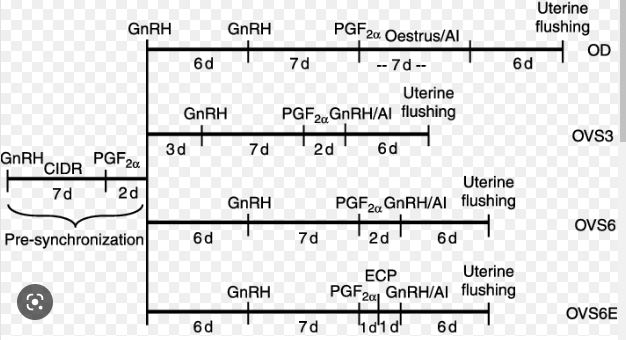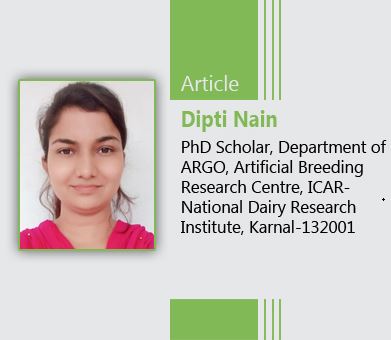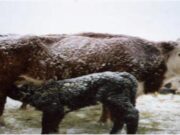
Now a day, various hormonal treatments are used for estrous synchronization in cattle. As donor and recipient should be in estrous synchrony, PGF2α treatment is given to the recipients 24 hours earlier than the donor to synchronize the estrous cycle of both donor and recipient. Main hormones which are used in synchronization are progesterone (P4), prostaglandins (PGF2α) and gondotrophins. Various synchronization protocols have been developed with help of these three hormones. Different protocols like ovsynch, co-synch used mainly at field level. Further some modifications have been done in these protocols to develop some new protocols.
Estrous synchronization
Manipulation of the estrous cycle in order to bring a group of females into estrus at a predetermined time is called as estrous synchronization (Odde, 1990). The pharmacological control of estrous cycle is based on two approaches: 1. Either shortening the life span of CL by inducing early luteolysis by using PGF2α. 2. Extending the life of CL by administration of P4.
Three hormones used for synchronization of estrous
Progesterone
Progesterone is the dominant ovarian hormone present in the circulation during the estrous cycle and is secreted from the corpus luteum (CL). This period of the estrous cycle is also referred to as the luteal phase and lasts from the time of ovulation until regression or luteolysis of the CL near the end of the cycle. Progestins suppress estrus in cattle and have been used extensively to alter the estrous cycle. This led to many studies in which progestins were administered by injection, released by an intra-vaginal sponge, or fed for a period of up to and exceeding the length of the estrus cycle to synchronize estrus following the cessation of administration. It was determined that an increased duration of progestin administration resulted in an increased rate of estrus synchronization. However, fertility was compromised following administration of progestins for 14 days. Some progesterone based protocols for synchronization of estrous are:
Controlled Internal Drug Release (CIDR)
CIDR is made up of a thin layer of silicon and progesterone mixture (10% w/w) around a nylon spine under high temperature. It contains 1.38gm of P4. It maintains high concentration of P4 of 2.0 ng/ml for 10 days. It is very easy to insert in the vagina of female animal. It is kept for 7 days in the vagina of female and provides an exogenous source of P4 to the animals. After its removal there will be sudden decrease in P4 concentration which leads to estrous synchronization. PGF2α is administered one day before the removal of CIDR. Advantage of CIDR + PGF2α is that it increases synchronization rate by approximately 30% and pregnancy rate by 20% both in anestrous and cyclic females.
Progesterone Releasing Intra-vaginal Device (PRID)
Device consistsof 1.55gm of P4 inserted into vagina for 7-10 days and injects PGF2α one day before the removal of device, animal will come to heat within 2-4 days.
TRIU-B: Device consists of 3 medicated rings (green colour) containing P4 IP 186mg each and one additional ring (pink colour) with P4 IP 400mg.
Melengesterol Acetate Feeding
- MGA alone: MGA feed is given to the animals for 14 days so that each female receive 0.5 mg/head/day. At 14th day MGA feed is removed and female start to show estrous. This estrous is not recommended to breed because it is sub-fertile. Animal is bred at the 2nd estrous.
- MGA + PGF2α: In this method MGA is fed for 14 days. Prostaglandins administration is done 16-18 day after the last day of MGA feeding. PGF2α given in late luteal phase in this method because it is more effective during the late luteal phase as compared to early luteal phase.
- Ear Implants: (1) Synchromate B: Implant contains 6 mg of norgestomet. Injection contains 5 mg estradiol valerate and 3.0mg norgestomet. Injection is administered at the time of implant insertion. (2) Crestar: Injection contains 3.0mg of norgestomet. Injection contains 5.0 mg estradiol valerate and 3.0 mg norgestomet. Injection is administered at the time of implant insertion.
Prostaglandins
PGF2α is produced by the endometrial gland of uterus and causes luteolysis. During the 1970s, it was discovered that PGF2α was luteolytic in cattle and could be used to synchronize estrus (Lauderdale et al., 1974). It was later determined that PGF2α had limited utility in synchronizing estrus because it was only effective in cattle that were cycling and had a CL (day 5 to 17 of the cycle). Therefore, prepubertal heifers, anestrous females, females on day 0 to 4 of the estrous cycle, and females in the final days of the estrous cycle subsequent to luteolysis were not responsive. It was later determined that the interval from treatment with PGF2α to estrus was dependent upon the stage of the follicular wave at treatment (Lucy et al., 1992). Larger, more mature follicles ovulated sooner than their smaller, less mature counterparts.
One shot PGF2α
Cyclic females are administered with an injection of PGF2α. When these female express estrous they are bred. But one-third of the females do not respond to this treatment. This protocol is very cheap and can be used for poor farmers. Most of the females come to estrous.
Two shot PGF2α: Two injections of PGF2α given at an interval of 11-12 days if the estrous cycle in cow is unknown. Detection of estrous is not required before or between injections. 2nd injection given only to females those do not come in estrous. It lowers the cost and handling problems.
Gonadotrophins
Combination of GnRH and PGF2α are good for cyclic females. Administration of GnRH causes regression or ovulation of the dominant follicle and initiates the emergence of a new wave of follicular growth. Atresia or ovulation of the dominant follicle depends upon the status (growing, static, regressing) of the dominant follicle at the time of GnRH injection. Pursley et al. (1995) reported that if a GnRH injection is given 48h after PGF2α injection will reduce the range in ovulation time to 8h (72-80 hr post- PGF2α). Based on GnRH and prostaglandins there are some protocols:
- Select Synch
Select synch is the breeding option for those herds with good heat detection programs and that prefer to breed animal based to standing estrus. This is the simplest GnRH based protocol. In this protocol, single dose of GnRH and PGF2α is injected on day 0 and 7 respectively. Early heats are fertile and the cows are inseminated after 72 hours after detection of heat. The select synch saves on hormonal costs because only those cows that fail to show estrus receive the 2nd GnRH injection. Select synch also facilitate more efficient use of expensive or genetically valuable semen by targeting its use in cows at estrus, whereas less expensive semen can be reserved for the times AI services.
(B) Ov-synch
This is GnRH-PGF2α-GnRH system. One extra injection of GnRH is given than select synch. This injection is given after 2 or 3 days of PGF2α. The ovsynch protocol comprise of an injection of GnRH on day 0, an injection of prostaglandin on day 7, a second GnRH injection on day 9 and then timed insemination on day 10 (Pursley et al., 1995). Highest pregnancy rate is achieved when insemination is done 16h after the second GnRH injection. The first GnRH injection alters follicular growth by inducing ovulation of the largest follicle (dominant follicle) in the ovaries after the GnRH injection to form a new or additional CL. PGF2α causes the lysis of natural CL and the secondary CL. A new group of follicle appears after GnRH injection on 10th day.
(C) Co-Synch
This program is comprised of an injection of GnRH on day 0, an injection of PG on day 7 and then a second GnRH with breeding on day 9. It is used extensively for beef herds. Co-synch eliminates one animal handling by breeding cows coinciding with the second GnRH injection. A small reduction in conception rate occurs when co synch is compared with ov-synch protocol.
(D) Heat synch
This protocol consists of injection of GnRH on day 0 and PGF2α on day 7. On day 8, estradiol ester (Estradiol ester 1.0 mg I/M) is administered. Animals are artificially inseminated in detected estrus or fixed time AI after 48 hrs of estradiol treatment.
(E) Hybrid Synch
This protocol comprise of GnRH on day 0, an injection of PGF2α on day 7 and then estrus detection and breeding from day 7-10. Females which don’t come in heat from day 7-10 are bred on day 10 and given a second injection of GnRH. This protocol appears to have the highest conception rates among all GnRH- PGF2α protocols.
(F) Double Synch
A modification of Ovsynch protocol, called as Double synch protocol has been developed by incorporating an additional PGF2α administration at 48h before the start of Ovsynch protocol and claimed to yield superior results.
(G) Pre-synch
Presynch as the name implies, is a protocol which “pre-synchronizes” bovines to the early stage of estrous cycle for optimum response to GnRH and thereby improves pregnancy rates to ovsynch. Pre-synch involves the use of two PGF2α injections given at 12-14 days apart with the last injection given 12-14 days before the initiation of ovsynch protocol. With a true presynch, a PGF2α injection is given prior to the voluntary waiting period. Breeding cows after these early heats will likely result in compromised conception due to incomplete uterine involution.
(H) Estradouble Synch
Another modification of the Ovsynch protocol, called as Estradouble synch has been developed by ICAR-NDRI recently and shown to yield good results in dairy animals especially in buffaloes. The protocol involve administration of PGF2α without regard to the stage of the estrous cycle (day of first PGF2α treatment, day 0), followed by GnRH on day 2, and by a second PGF2α treatment on day 9, followed by an Estradiol Benzoate treatment (1.0 mg) 24 h after the second-PGF2α (day 10) and TAI is performed at 48 and 60 h after EB treatment.
(I) CIDR-GnRH based
The CIDR-GnRH, based protocol involves insertion of the CIDR on day1 and withdrawal of the CIDR on day 8. An injection of GnRH is given on day of CIDR insertion. On the day of CIDR withdrawal, an injection of prostaglandin is given. The second GnRH injection is given after two days of prostaglandin injection. The advantage of inclusion of the CIDR in GnRH-based programs is that the animal is exposed to progesterone during the period between day 1 and day 8 which will prevent early onset of estrus and ovulation between days 1 and 9 that are inherent to the GnRH- PGF2α systems. These are the all methods by which recipients can be synchronized with the donor so that they will be in the same stage of estrous cycle as the donor. Mean interval from PGF2α injection to onset of estrus is shorter in super-ovulated donors than normal recipient females. Recipients are given PGF2α, 12-24 hours earlier than the donor for getting efficient synchronization of estrus between donor and recipients for embryo transfer works.
Conclusion: In last decade, there has been much more improvement in synchronization of the donor and recipients. It is very important to maintain synchrony between the donor and recipient to get better embryo quality. Embryo transfer technology has been used for a long time but still there are some limitations due to insufficiency in estrus detection and synchronization in donor and recipients. It is advantageous to embryo transfer in the recipient with higher P4 concentration and larger CL especially when working with indigenous cattle.

Dipti Nain1, Tushar K. Mohanty2, Hanuman P. Yadav3, Raju Kr. Dewry4, and Aye Soe1
1PhD Scholar, Department of ARGO, Artificial Breeding Research Centre,
ICAR-National Dairy Research Institute, Karnal-132001
2Principal Scientist, Department of ARGO, ABRC, ICAR-NDRI, Karnal-132001
3Assistant Professor, Department of VGO, Ranchi Veterinary College, BAU, Ranchi- 834006
4SRF, Division of Animal and Fisheries Sciences, ICAR-Research Complex for NEH Region, Umiam, Meghalya-793103



















